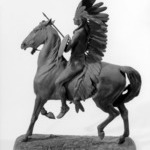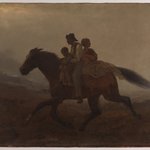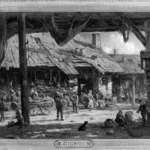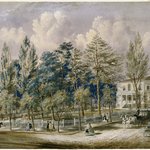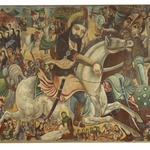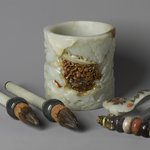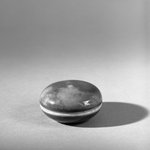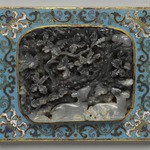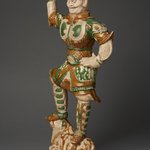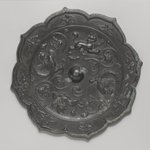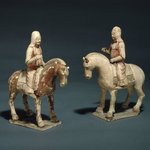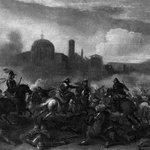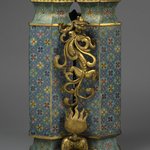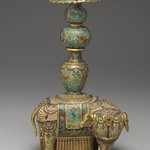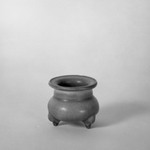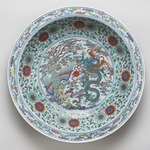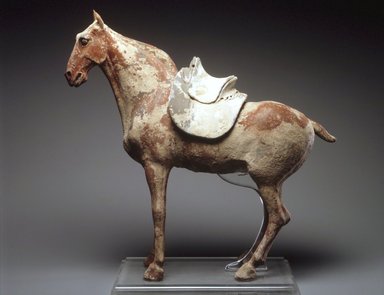
Figure of a Horse with Saddle
Asian Art
On View: Asian Galleries, West, 2nd floor (China)
Horses were prized in China not only for their nobility and prowess in war but also because they were believed to be imbued with supernatural qualities. During the Han through Tang dynasties, military expansion to the far western regions was spurred by the quest for heavenly horses, also called “blood-sweating horses,” which were associated with dragons. The fastest battle horses were thought to be found in the region of Ferghana, in Central Asia. In the tomb context, horses signified high rank but might also serve as celestial vehicles for the deceased to journey to the realm of immortals.
MEDIUM
Earthenware, traces of pigment
DATES
late 6th century
DYNASTY
Northern Dynasties
PERIOD
Northern and Southern Dynasties
DIMENSIONS
19 1/2 x 22 x 5 1/2 in. (49.5 x 56.0 x 14.0 cm) (show scale)



COLLECTIONS
Asian Art
ACCESSION NUMBER
1999.138a-b
CREDIT LINE
Gift of Peter W. Scheinman
CATALOGUE DESCRIPTION
Chinese ceramic tomb figure of a horse with a separate saddle, the horse standing on four legs without a base, the figure molded and hand-finished, the clay body fired a deep, even gray color, the horse painted a deep red-brown pigment and covered with an encrustation of soil from burial, the soil and paint flaking unevenly from the surface. The ends of an iron armature are visible on the bottom three of the four hooves.
The body of the horse is especially thick, the interior visible through a large opening on the horse's stomach, with finger marks from the original modeling visible around the opening and the impression of a bundle of coarse straw or similar material in the interior of the horse's body, the straw lost during firing. The saddle is molded and hand finishes, with traces of red-brown pigment on some details and white-gray pigment on the seat. Adhesive label on the underside of the saddle from Christie's\23mar95\101 (?)\30.
With the introduction of the famous Fereghan horses from Central Asia, the course of Chinese history shifted significantly. Warfare, pageantry, and trade were affected by this development, as was Chinese art. The realistic modeling of these two sixth-century horses represents a long tradition of the equine form in funerary sculpture. The dynamic movement portrayed by the figure's turned torso is a new element of the era. Saddles became important decorative objects themselves in later periods, as shown by the silver saddle ornaments also displayed here. (Gallery Chat Label, 2007 - shared with 37.126)
Condition: The horse and saddle are currently intact, with evidence of previous damage and repair, especially to the legs of the horse. Firing cracks visible inside the body. Evidence of some overpainting in red-brown to match the original color and to cover losses of original pigment of burial encrustation. Recommend non-obtrusive examination to identify areas of repair and/or restoration, as well as to locate the original iron armature.
EXHIBITIONS
MUSEUM LOCATION
This item is on view in Asian Galleries, West, 2nd floor (China)
CAPTION
Figure of a Horse with Saddle, late 6th century. Earthenware, traces of pigment, 19 1/2 x 22 x 5 1/2 in. (49.5 x 56.0 x 14.0 cm). Brooklyn Museum, Gift of Peter W. Scheinman, 1999.138a-b. Creative Commons-BY (Photo: Brooklyn Museum, 1999.138a-b_transp4807.jpg)
IMAGE
overall, 1999.138a-b_transp4807.jpg. Brooklyn Museum photograph
"CUR" at the beginning of an image file name means that the image was created by a curatorial staff member. These study images may be digital point-and-shoot photographs, when we don\'t yet have high-quality studio photography, or they may be scans of older negatives, slides, or photographic prints, providing historical documentation of the object.
RIGHTS STATEMENT
Creative Commons-BY
You may download and use Brooklyn Museum images of this three-dimensional work in accordance with a Creative Commons license. Fair use, as understood under the United States Copyright Act, may also apply.
Please include caption information from this page and credit the Brooklyn Museum. If you need a high resolution file, please fill out our online application form (charges apply).
For further information about copyright, we recommend resources at the United States Library of Congress, Cornell University, Copyright and Cultural Institutions: Guidelines for U.S. Libraries, Archives, and Museums, and Copyright Watch.
For more information about the Museum's rights project, including how rights types are assigned, please see our blog posts on copyright.
If you have any information regarding this work and rights to it, please contact copyright@brooklynmuseum.org.
RECORD COMPLETENESS
Not every record you will find here is complete. More information is available for some works than for others, and some entries have been updated more recently. Records are frequently reviewed and revised, and we welcome any additional information you might have.

